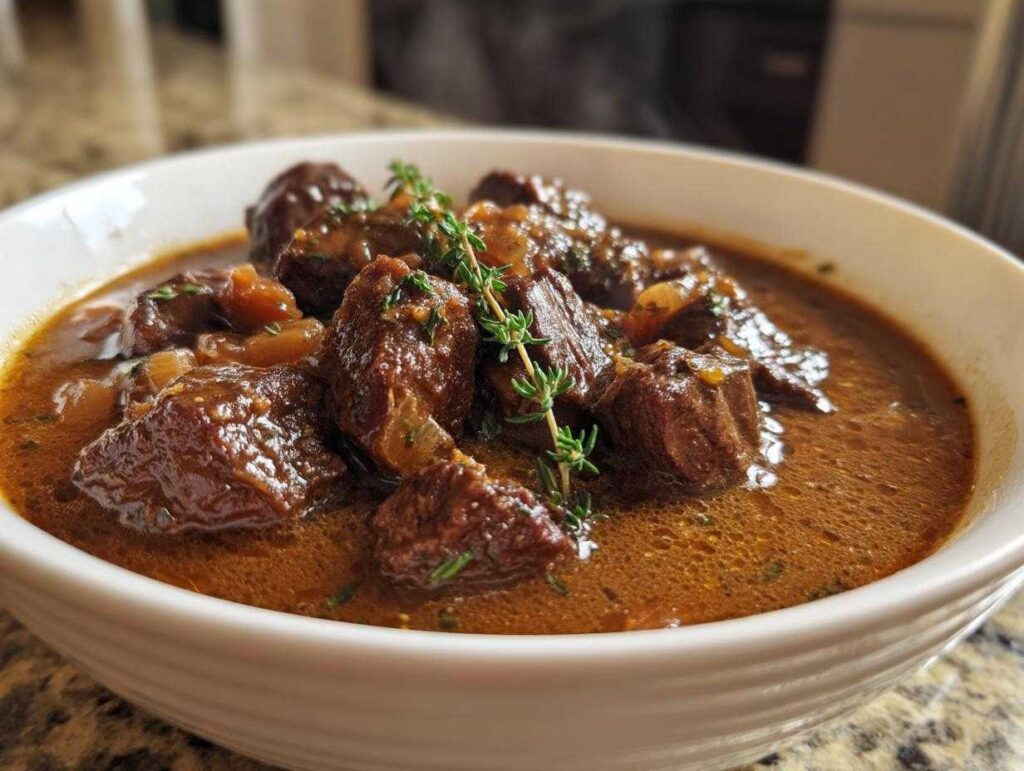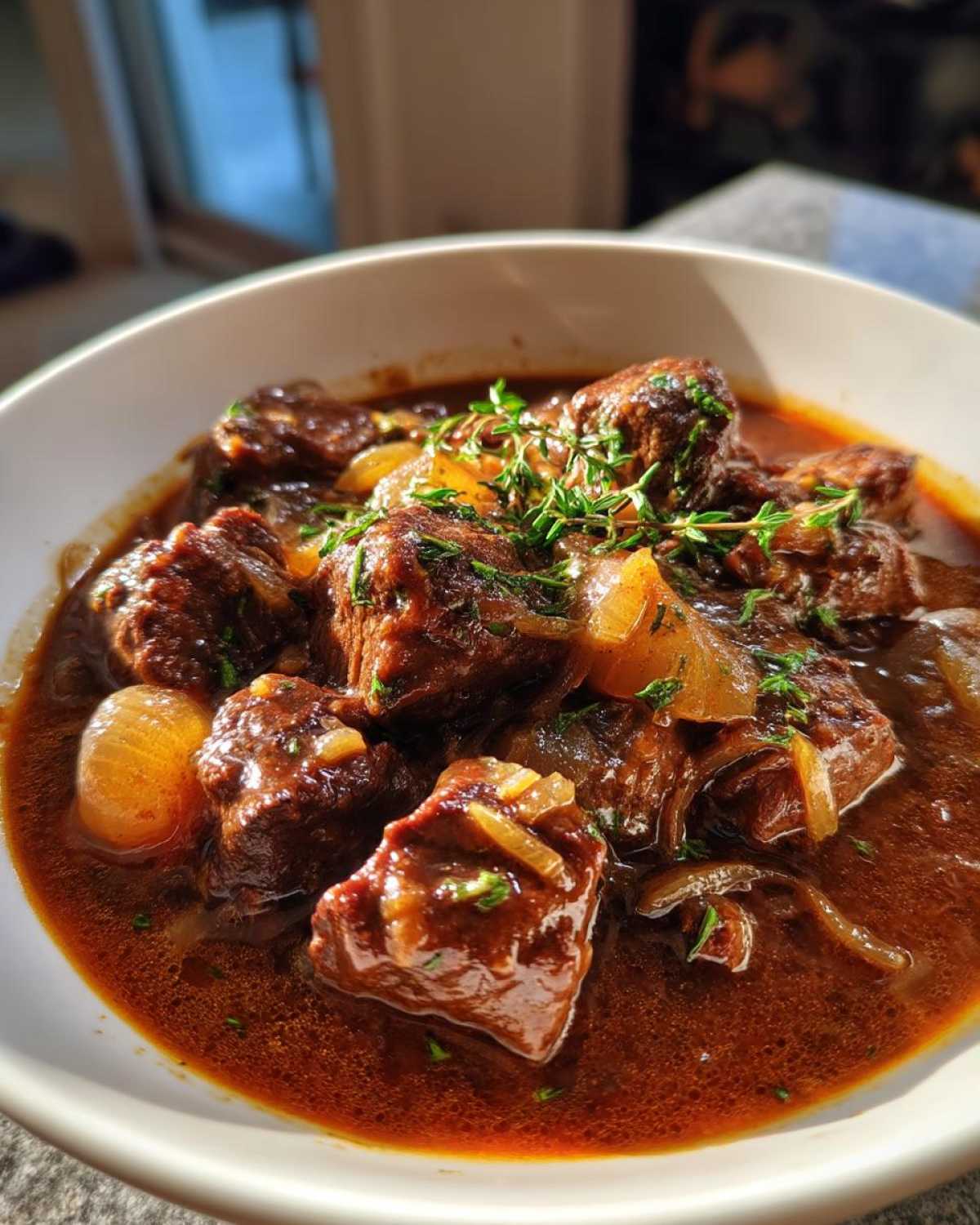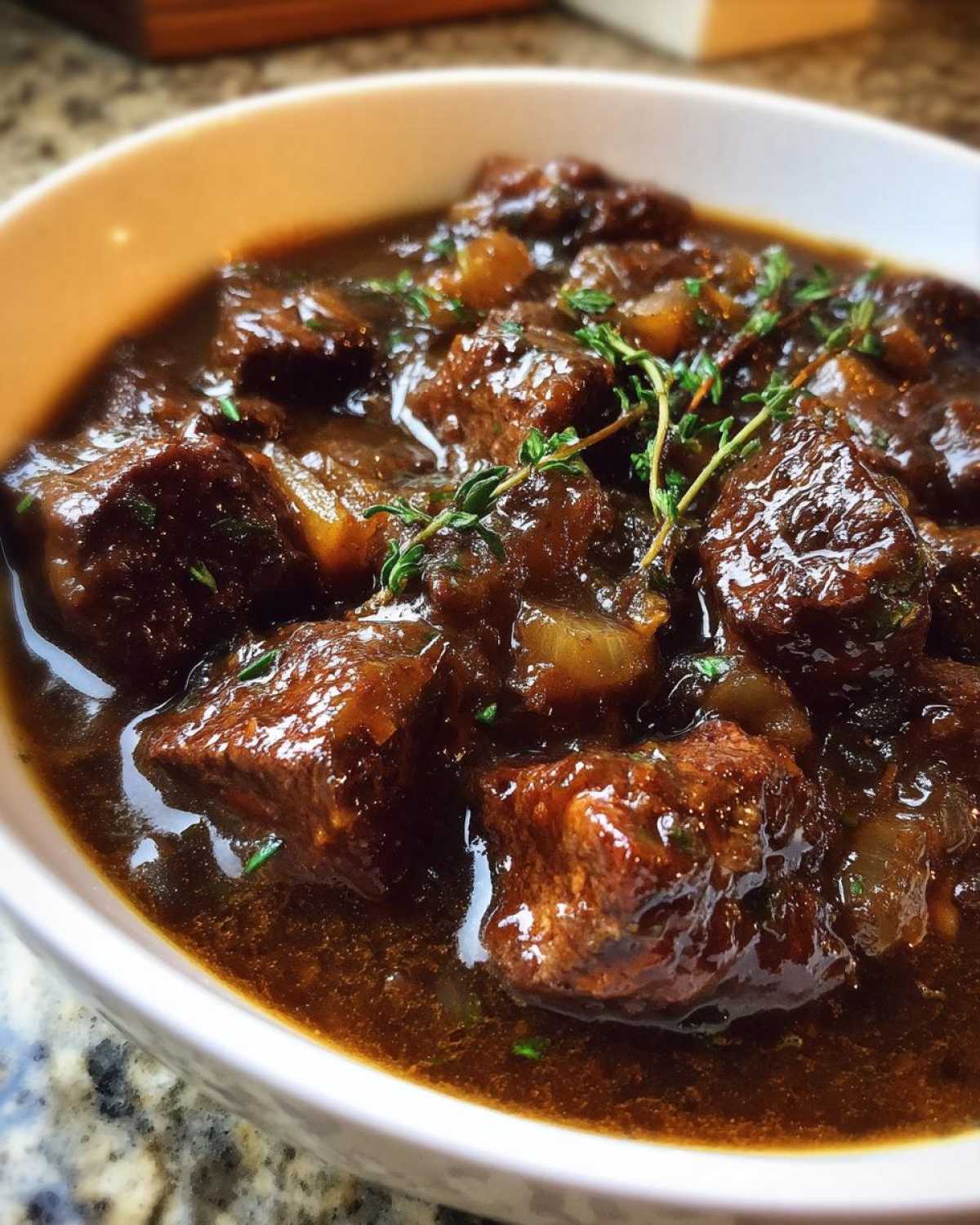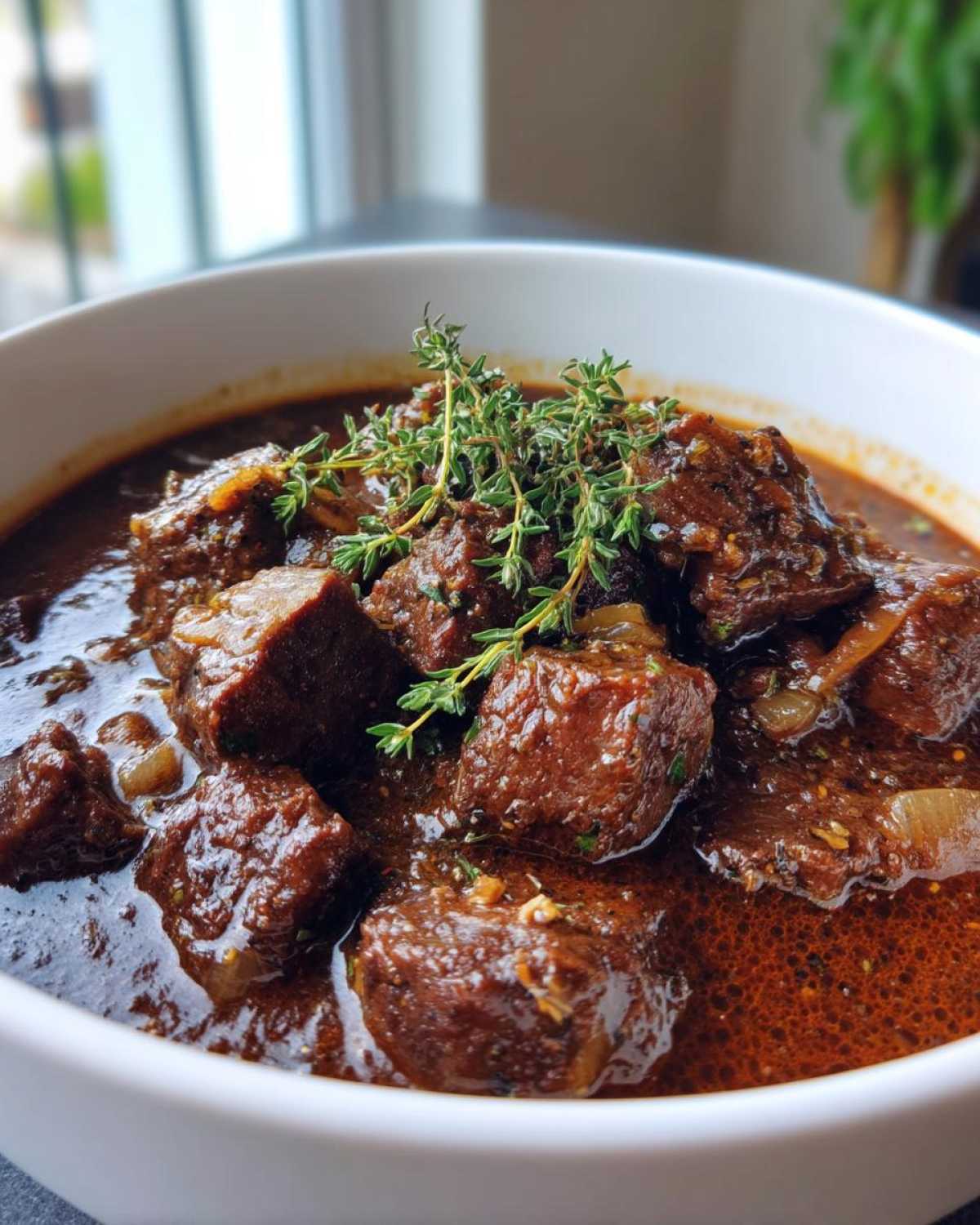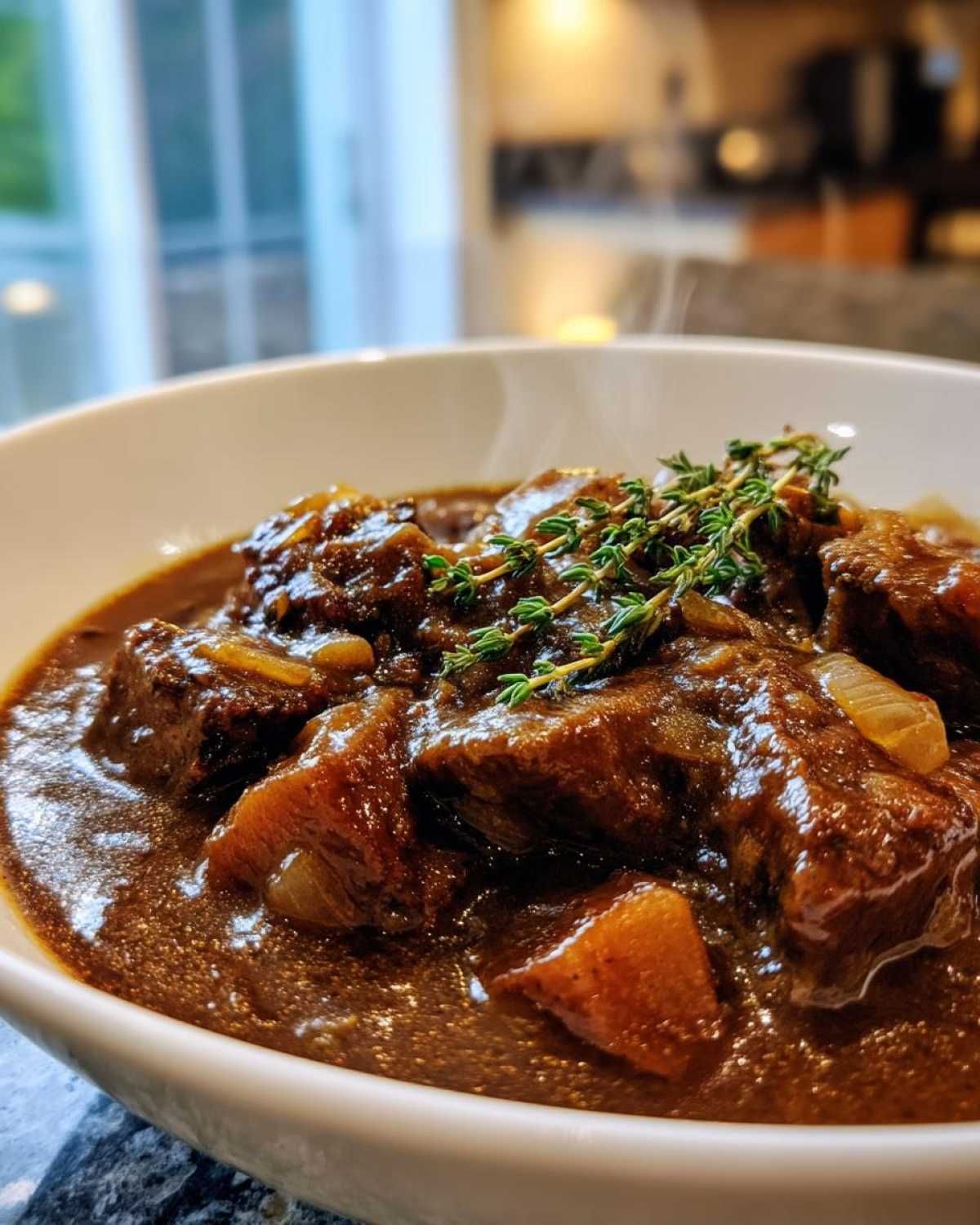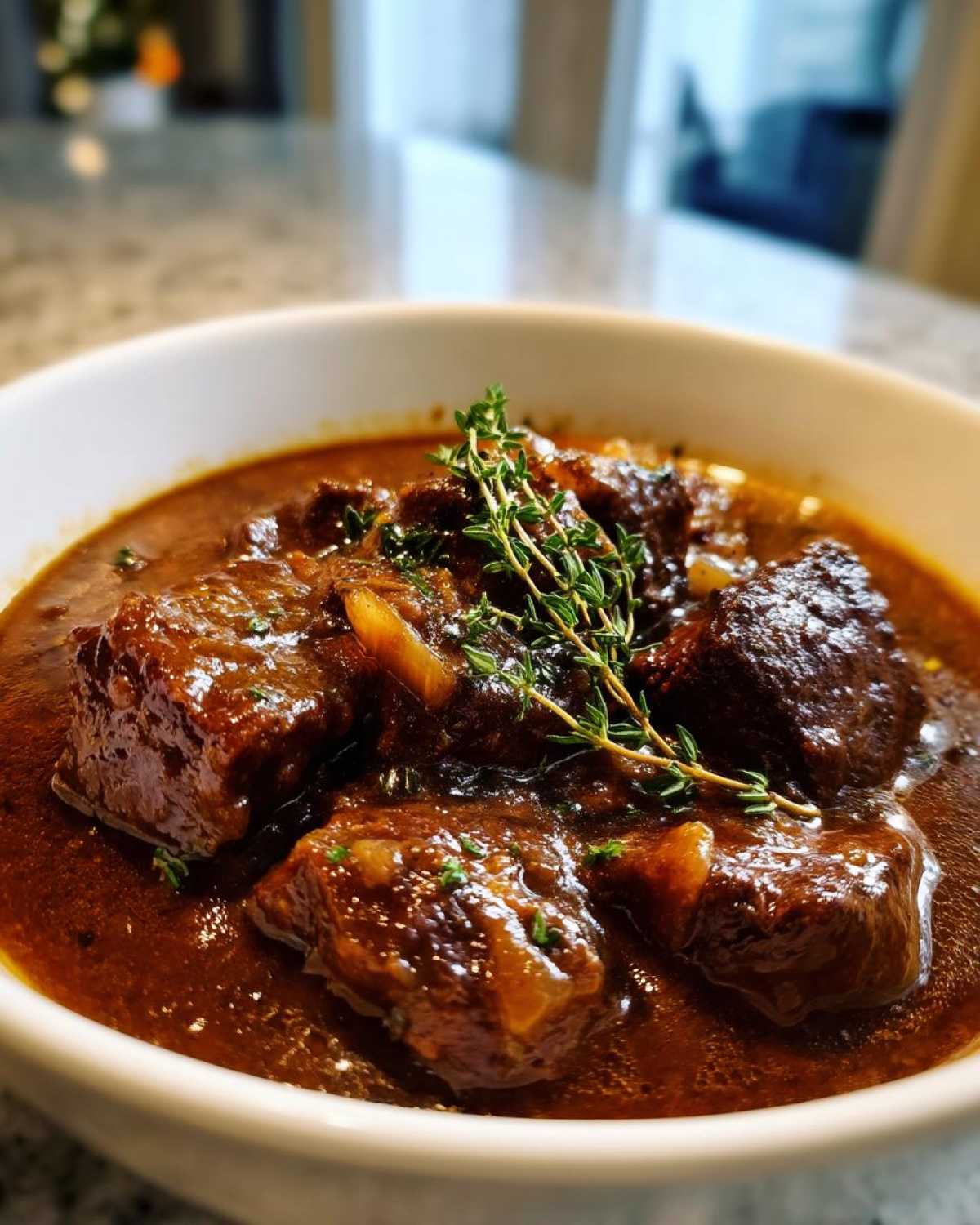There’s something magical about a pot of french onion beef stew bubbling away on the stove – that rich aroma of caramelized onions and tender beef filling the kitchen just like my grandmother’s did every Sunday. I can still picture her standing at the old cast iron stove, wooden spoon in hand, patiently stirring those onions until they turned golden brown. “The secret’s in the patience,” she’d say with a wink as the kitchen filled with that unmistakable sweet, savory scent.
This french onion beef stew is my modern take on those comforting memories – deep, beefy flavors melded with sweet onions and a splash of red wine that makes the whole house smell like a French bistro. It’s the kind of meal that warms you from the inside out, perfect for chilly evenings when you need a big, satisfying hug in a bowl. And just like Grandma taught me, the real magic happens when you let it simmer low and slow until the beef practically melts on your fork.
- Why You’ll Love This French Onion Beef Stew
- Ingredients for French Onion Beef Stew
- How to Make French Onion Beef Stew
- Tips for the Best French Onion Beef Stew
- French Onion Beef Stew Variations
- Serving Suggestions
- Storing and Reheating
- French Onion Beef Stew FAQs
- Nutritional Information
- Try This Stew Tonight and Share Your Results!
Why You’ll Love This French Onion Beef Stew
This isn’t just any beef stew—it’s a hug in a bowl with deep, caramelized flavors that’ll make your taste buds sing. Here’s why it’s a forever favorite in my kitchen:
- Rich, cozy flavor: Sweet onions cooked low and slow melt into the broth, while red wine adds that fancy French bistro touch (without the fuss).
- Weeknight magic: Brown the beef, caramelize the onions, then let the pot do the work—perfect for busy days when you want something hearty with minimal effort.
- Cold-weather champion: Steam rising from the bowl, tender beef, that golden broth… it’s basically a wool sweater for your soul.
- Your rules: Swap the wine for broth, add mushrooms, or top with that plant-based whipped cream for a fun twist—it’s all good!
Ingredients for French Onion Beef Stew
Gather these simple ingredients – trust me, every one plays a special role in creating that deep, comforting flavor we’re after. I always lay everything out before starting (Grandma called it “mise en place” before I even knew what that meant!).
- 2 tbsp olive oil – for that perfect sear
- 2 lbs beef chuck, cut into 1-inch cubes (fat = flavor!)
- 1 large onion, thinly sliced (no rushing the caramelization!)
- 2 garlic cloves, minced (because everything’s better with garlic)
- 4 cups beef broth – go for low-sodium so you can control the salt
- 1 cup dry red wine (or sub with extra broth if needed)
- 1 sprig fresh thyme – that earthy note makes all the difference
- 1 bay leaf – the quiet hero of the spice world
- Salt & pepper to taste (I’m generous with both)
- 2 tbsp all-purpose flour (contains gluten – see notes for GF options)
- Plant-based whipped topping (optional, but oh-so-fun for serving!)
See? Nothing fancy – just good, honest ingredients that transform into something magical together. Now let’s get cooking!
How to Make French Onion Beef Stew
Alright, let’s get this cozy masterpiece going! Follow these steps and you’ll have a pot of pure comfort in no time. Just remember – good things come to those who wait (especially when it comes to those onions!).
Browning the Beef
First things first – pat your beef cubes dry with paper towels (this helps them brown beautifully). Heat that olive oil in your Dutch oven or heavy pot over medium-high heat until it shimmers. Now, here’s my golden rule: don’t crowd the pan! Brown the beef in batches if needed – I know it’s tempting to dump it all in, but trust me, overcrowding steams the meat instead of searing it. Give each piece some breathing room and let it develop that gorgeous crust on all sides. That browned goodness equals flavor gold in your stew!
Caramelizing the Onions
Once the beef is browned and set aside, in go the onions. Turn the heat down to medium-low – this isn’t a race! Stir them occasionally and let them work their magic for 10-15 minutes. You’ll see them go from sharp and white to soft and golden, then finally to that perfect caramel color. This is where the magic happens! If they start sticking, just add a splash of broth to loosen those tasty browned bits. When you smell that sweet, almost nutty aroma, you’ll know they’re perfect.
Simmering to Perfection
Now for the easy part! Return the beef to the pot with the onions, sprinkle in the flour and stir for about a minute to cook off that raw flour taste. Pour in your broth and wine (stand back – it’ll sizzle gloriously!), then add the thyme and bay leaf. Bring it all to a gentle simmer, scraping up every last bit of flavor from the bottom of the pot. Cover with the lid slightly ajar and let it bubble away on low heat for 1.5 to 2 hours. The longer it simmers, the more tender that beef becomes. Just fish out the thyme stem and bay leaf before serving – nobody wants to bite into those!
Tips for the Best French Onion Beef Stew
Want to take your stew from good to “can I have thirds?” good? Here are my tried-and-true tricks:
- Thicken it right: If your stew needs more body, mix 1 tbsp flour with 2 tbsp cold water into a slurry and stir it in during the last 15 minutes of cooking – no lumps!
- Wine wisdom: That splash of red wine isn’t just for flavor – it helps deglaze all those delicious browned bits from the pan. No wine? Use extra broth with a teaspoon of vinegar for brightness.
- Better tomorrow: This stew tastes even better made ahead! The flavors meld beautifully overnight in the fridge – just reheat gently on the stove.
See? Little touches make all the difference between good and unforgettable!
French Onion Beef Stew Variations
This recipe is wonderfully flexible – here are my favorite ways to mix it up when I’m feeling creative (or just using what’s in my fridge):
- Meat swap: Try beef short ribs instead of chuck – they’ll fall-off-the-bone tender after long simmering.
- Broth boost: Mushroom broth adds incredible umami depth if you want to go vegetarian.
- Wine-free: No red wine? Use extra broth with a splash of balsamic vinegar for that tangy kick.
The beauty? It’s still that same comforting stew at heart!
Serving Suggestions
Oh, the possibilities! This stew loves company – I always serve it with crusty bread for dunking (that broth is liquid gold!). For heartier appetites, pile it over creamy mashed potatoes. A crisp green salad cuts through the richness beautifully. And that plant-based whipped topping? Sounds wild, but trust me – a dollop on top adds the most delightful creamy contrast. Pure comfort in every bite!
Storing and Reheating
This stew gets even better as leftovers – the flavors deepen overnight! Store cooled stew in an airtight container in the fridge for 3-4 days. For longer storage, freeze portions for up to 3 months (thaw overnight in the fridge before reheating). When ready to enjoy, warm it gently on the stove over low heat – a splash of broth revives the perfect consistency. Pro tip: The onions practically melt into the sauce after a day, making it even more luxurious!
French Onion Beef Stew FAQs
Got questions? I’ve got answers! Here are the most common things readers ask me about this cozy stew:
Can I make this in a slow cooker?
Absolutely! After browning the beef and caramelizing the onions (don’t skip these steps!), transfer everything to your slow cooker. Cook on LOW for 7-8 hours or HIGH for 3-4 hours. The beef will be fall-apart tender!
What can I use instead of red wine?
No worries! Swap it with equal parts extra beef broth plus 1 teaspoon of balsamic vinegar or Worcestershire sauce for that depth of flavor. The stew will still taste amazing.
How do I thicken the stew if it’s too thin?
My go-to trick: mix 1 tablespoon flour with 2 tablespoons cold water into a smooth slurry, then stir it into the simmering stew during the last 15 minutes of cooking. It’ll thicken up beautifully without lumps!
Can I freeze leftovers?
You bet! This stew freezes like a dream. Just cool completely, then store in airtight containers for up to 3 months. Thaw overnight in the fridge before reheating gently on the stove.
Nutritional Information
Just so you know what you’re diving into (not that you’ll stop at one bowl!), here’s the nutritional scoop per serving. Remember, these are estimates – your exact amounts might vary based on ingredients and portion sizes:
- Calories: 450
- Protein: 35g (that beef packs a punch!)
- Fat: 25g (10g saturated – hello, flavorful chuck roast)
- Carbs: 15g (mostly from those sweet onions)
- Sodium: 800mg (use low-sodium broth if watching salt)
Not bad for a meal that tastes this indulgent, right? The protein keeps you full, while those caramelized onions add natural sweetness without loads of sugar. Comfort food that loves you back!
Try This Stew Tonight and Share Your Results!
There you have it – my all-time favorite french onion beef stew that’s been warming hearts (and bellies) for generations. I can’t wait for you to experience that first spoonful of rich, caramelized goodness! When you make it, snap a photo and tag me – I love seeing your kitchen creations. Did you add extra garlic? Swap the wine? Top it with that crazy-good whipped topping? Tell me all about it! Nothing makes me happier than knowing this recipe is bringing cozy moments to your table, just like it has for my family. Now go grab that Dutch oven and let the comforting aromas begin!
PrintIrresistible French Onion Beef Stew in Just 2 Hours
This hearty stew combines tender beef with the rich flavors of caramelized onions, creating a comforting and satisfying meal.
- Prep Time: 20 minutes
- Cook Time: 2 hours
- Total Time: 2 hours 20 minutes
- Yield: 6 servings 1x
- Category: Main Course
- Method: Simmering
- Cuisine: French
- Diet: None
Ingredients
- 2 tablespoons olive oil
- 2 pounds beef chuck, cut into 1-inch cubes
- 1 large onion, thinly sliced
- 2 cloves garlic, minced
- 4 cups beef broth
- 1 cup dry red wine
- 1 sprig fresh thyme
- 1 bay leaf
- Salt and black pepper to taste
- 2 tablespoons all-purpose flour
- Plant-based whipped topping (optional, for serving)
Instructions
- Heat olive oil in a large pot or Dutch oven over medium-high heat. Add beef and brown on all sides. Remove beef from pot and set aside.
- Add sliced onion to the pot and cook until softened and lightly browned, about 10-15 minutes.
- Stir in minced garlic and cook for 1 minute more until fragrant.
- Return beef to the pot. Stir in flour and cook for 1 minute.
- Pour in beef broth and red wine. Add thyme and bay leaf. Bring to a simmer, scraping up any browned bits from the bottom of the pot.
- Reduce heat to low, cover, and simmer for 1.5 to 2 hours, or until beef is tender.
- Remove thyme and bay leaf. Season with salt and pepper to taste.
- Serve hot, optionally topped with plant-based whipped topping.
Notes
- For a thicker stew, you can create a slurry by mixing 1 tablespoon of flour with 2 tablespoons of cold water and stirring it into the stew during the last 15 minutes of cooking.
- You can substitute beef chuck with other cuts like stewing beef or short ribs.
- This stew can be made ahead of time and reheated. The flavors will meld even more.
Nutrition
- Serving Size: 1 serving
- Calories: 450
- Sugar: 5g
- Sodium: 800mg
- Fat: 25g
- Saturated Fat: 10g
- Unsaturated Fat: 12g
- Trans Fat: 0g
- Carbohydrates: 15g
- Fiber: 2g
- Protein: 35g
- Cholesterol: 100mg

